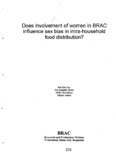| dc.contributor.author | Roy, Rita Das | |
| dc.contributor.author | Hyder, SM Ziauddin | |
| dc.contributor.author | Chowdhury, AMR | |
| dc.contributor.author | Adams, Alayne | |
| dc.date.accessioned | 2019-11-12T04:45:31Z | |
| dc.date.available | 2019-11-12T04:45:31Z | |
| dc.date.issued | 1997 | |
| dc.identifier.citation | Roy, R. D., Hyder, S. Z., Chowdhury, A., & Adams, A. (1997). Does involvement of women in BRAC influence sex bias in intra-household food distribution? Research Reports (1997): Health Studies, Vol - XXII, 234–257. | |
| dc.identifier.uri | http://hdl.handle.net/10361/12914 | |
| dc.description.abstract | This study aimed to assess the sex preference in intra-household food distribution among school
going siblings in a rural area of Bangladesh. The study also examines the effect of women's
involvement in BRAC's rural development programme in reducing gender gaps in intrahousehold
food allocation. The study was conducted in 14 villages of :Matlab thana as one of the
sub-studies of the BRAC-ICDDR,B joint research project. A total of 376 school-going siblings
(188 brothers and 188 sisters) aged 10-14 years from BRAC member and no~-member
households were included in this study. Both quantitative and qualitative research methods were
used for data collection. One of the villages was chosen for direct observation of food distnoution
behaviour of the food servers. The methodology also included six focus group discussions with
mothers of the siblings in two selected villages; this helped to have further understanding of the
issue. The survey found no significant sex bias in food distribution for 3 major daily meals.
However, boys were given preference in distributing special foods such as meat, fish and milk
products. Brothers conswned higher amount of special foods compared to their sisters (p<0.001).
Direct observation of food distribution and focus group discussions indicated that preferential
food distribution pattern favouring sons, which existed in the rural community irrespective of
social classes. It was also found that food was more equitably distributed between sons and
daughters within BRAC member households compared to non-member households. | en_US |
| dc.language.iso | en | en_US |
| dc.publisher | BRAC Research and Evaluation Division (RED) | en_US |
| dc.subject | Women | en_US |
| dc.subject | Food distribution | en_US |
| dc.subject | BRAC | en_US |
| dc.subject | Sex bias | en_US |
| dc.subject | Intra-household | en_US |
| dc.subject.lcsh | Parenteral feeding of children | |
| dc.subject.lcsh | Sex discrimination | |
| dc.subject.lcsh | School children--Food | |
| dc.subject.lcsh | Children--Nutrition | |
| dc.subject.lcsh | Household surveys | |
| dc.title | Does involvement of women in BRAC influence sex bias in intra-household food distribution? | en_US |
| dc.type | Research report | en_US |

